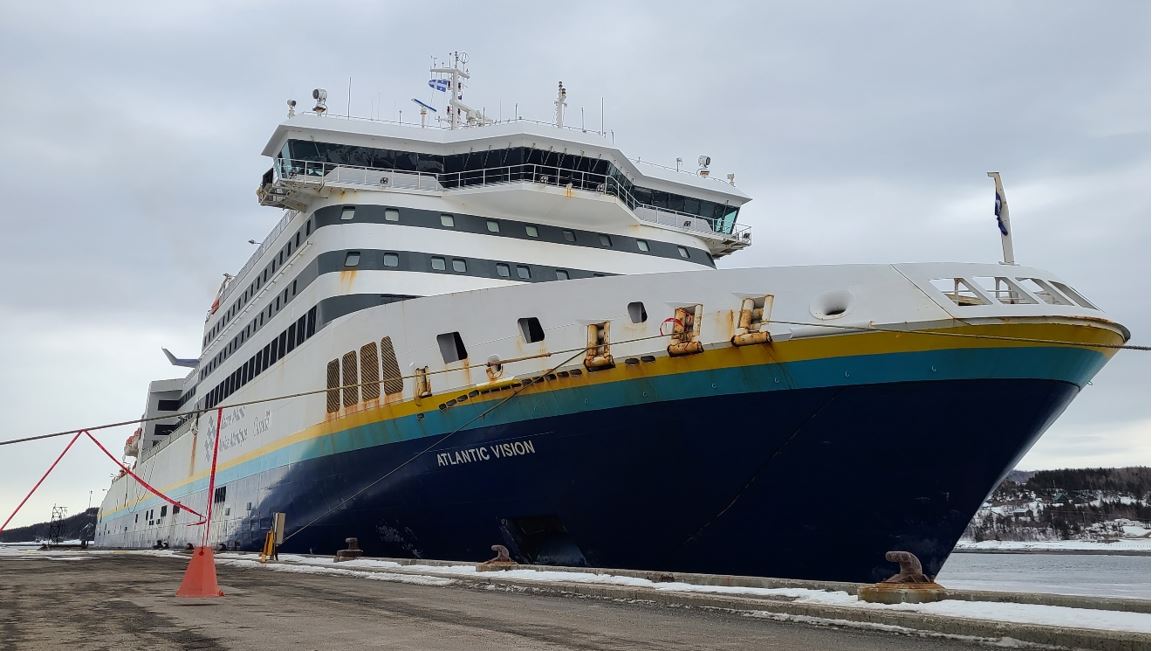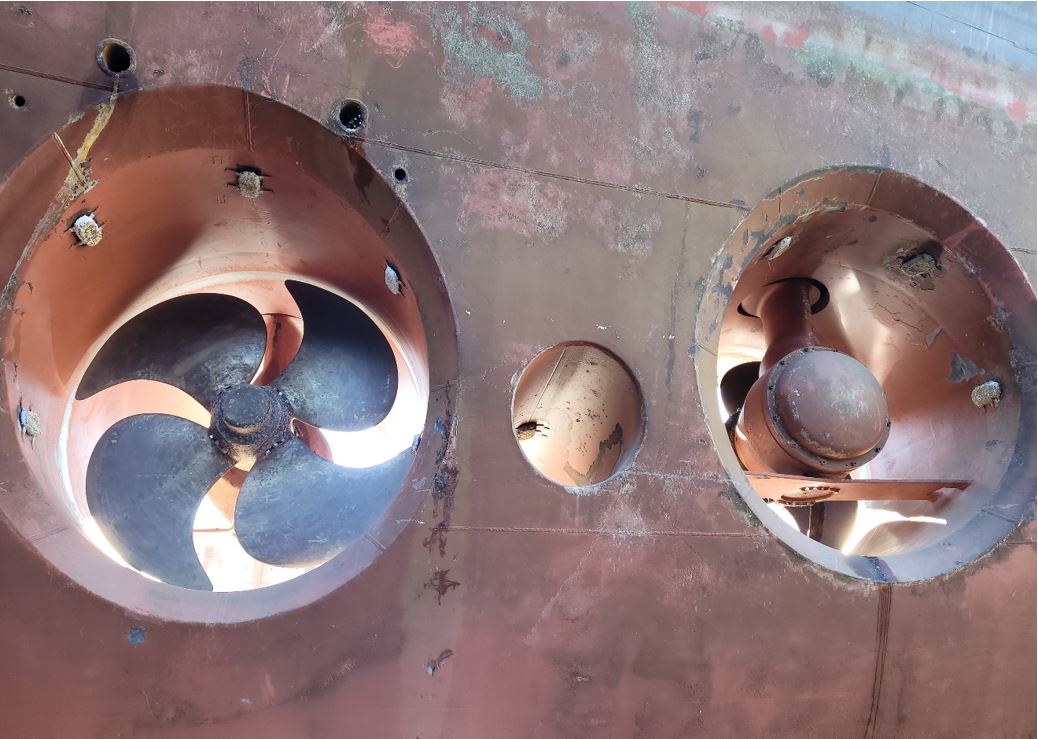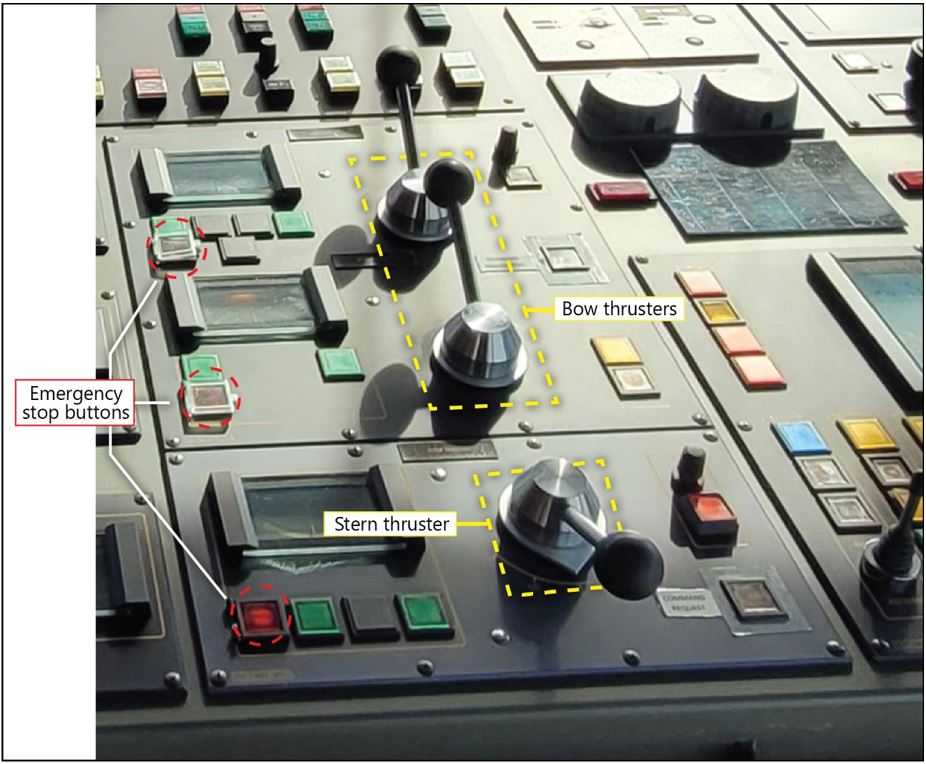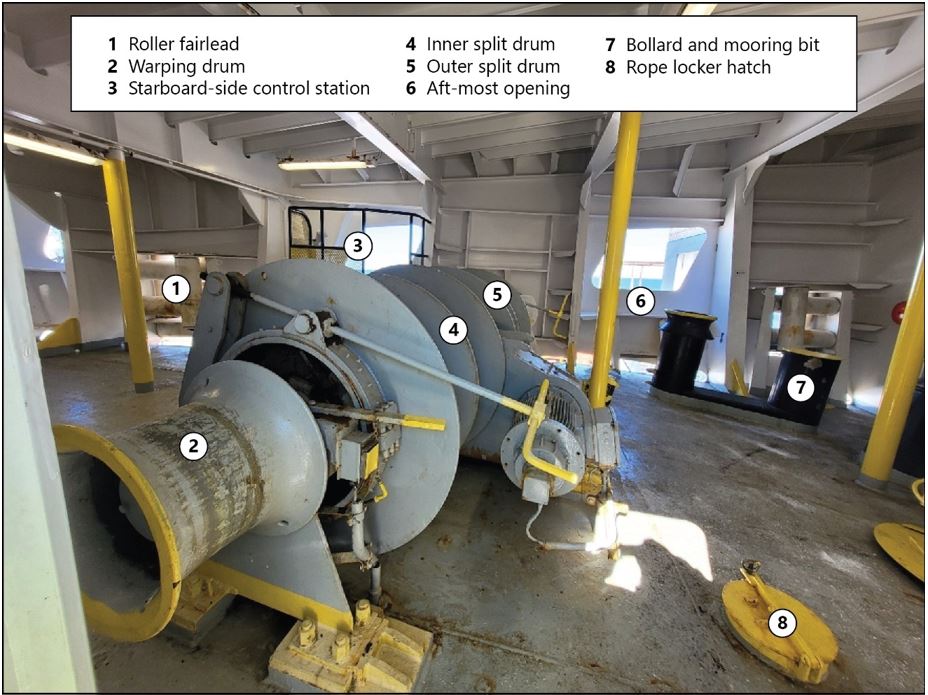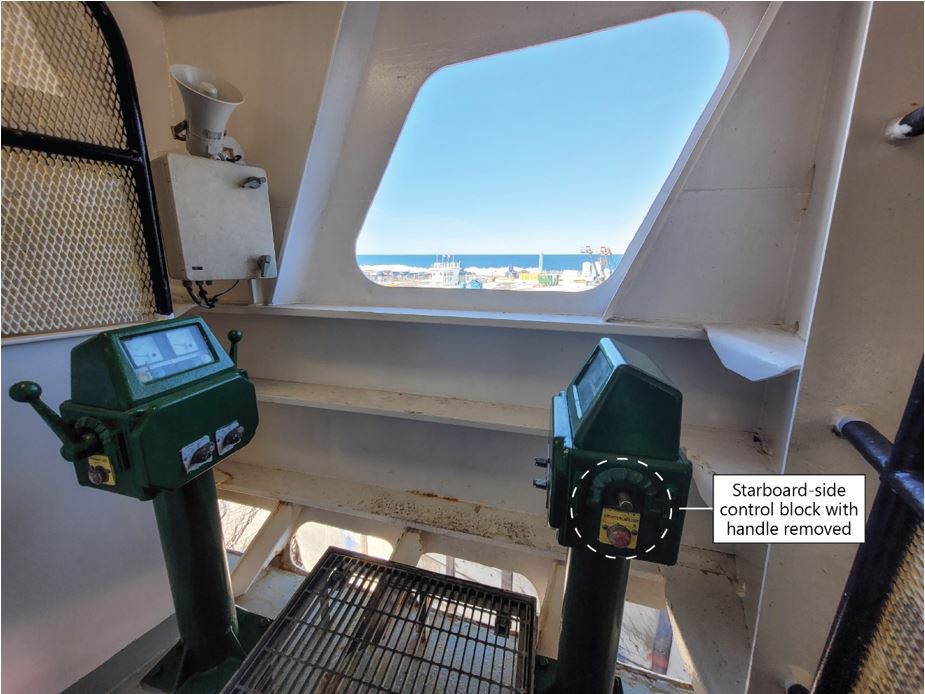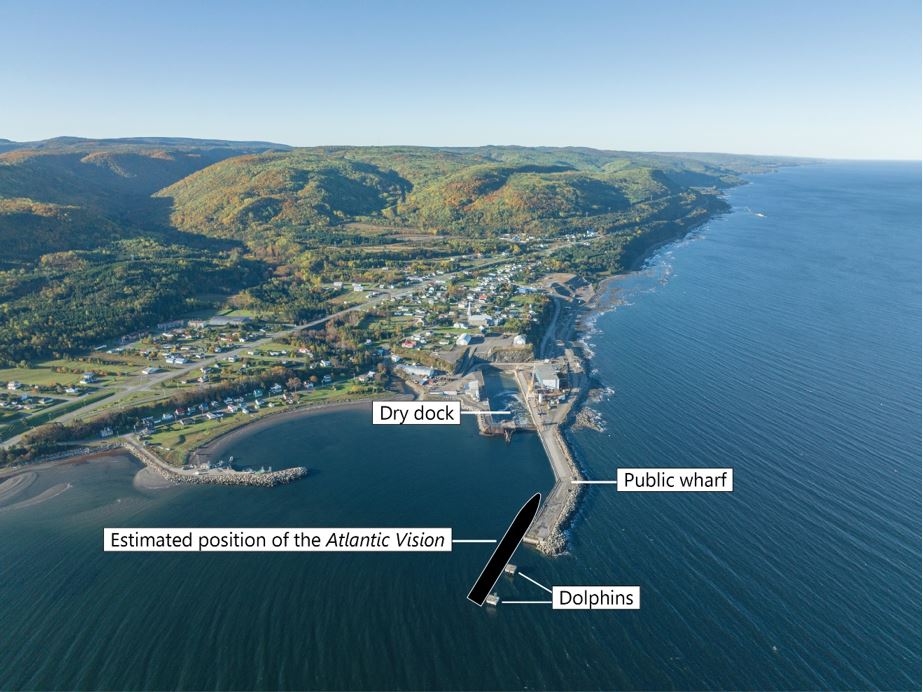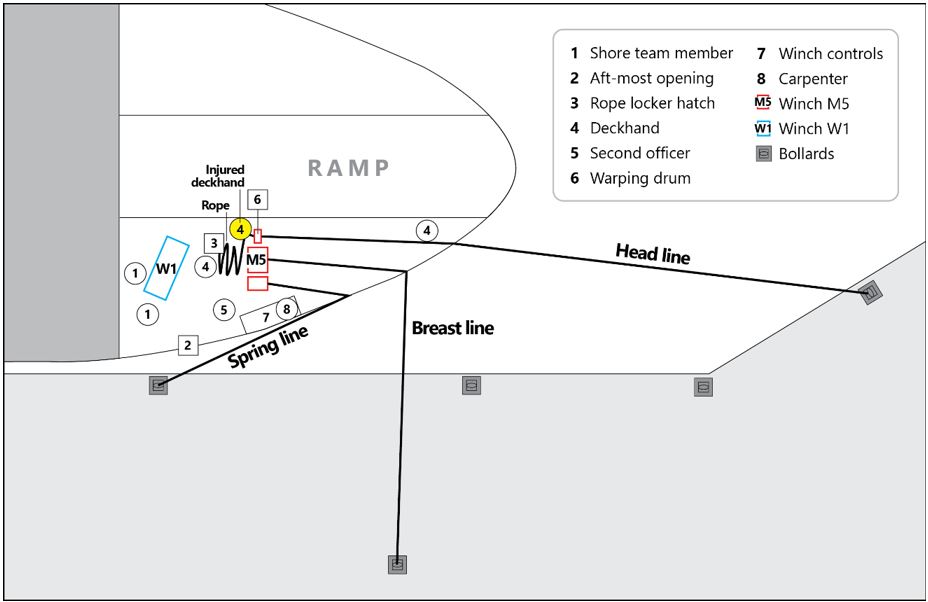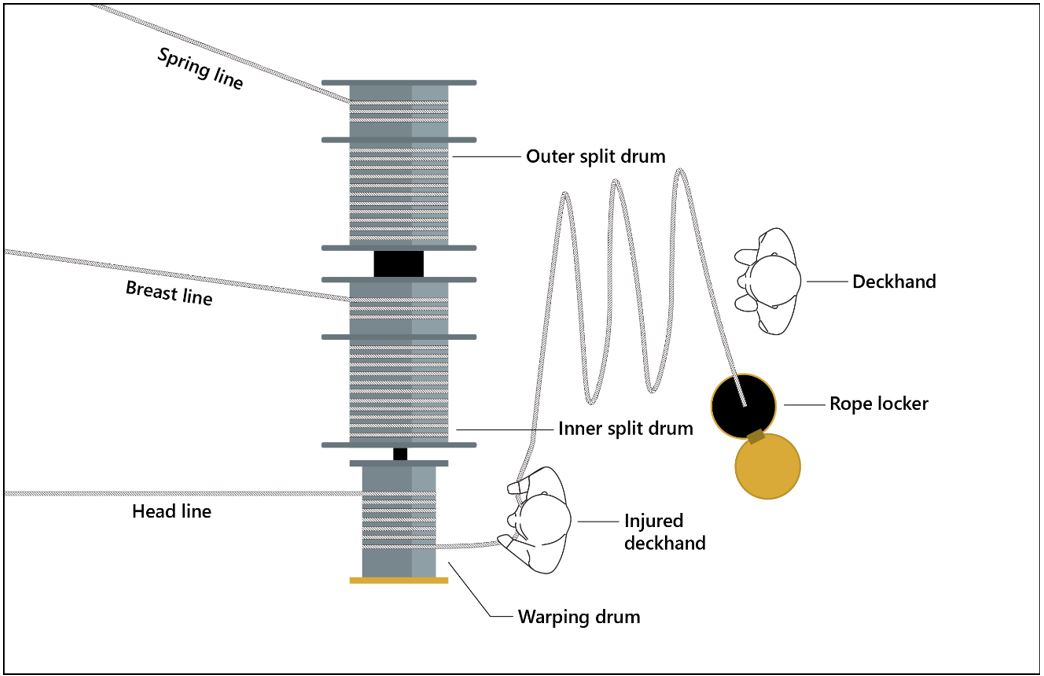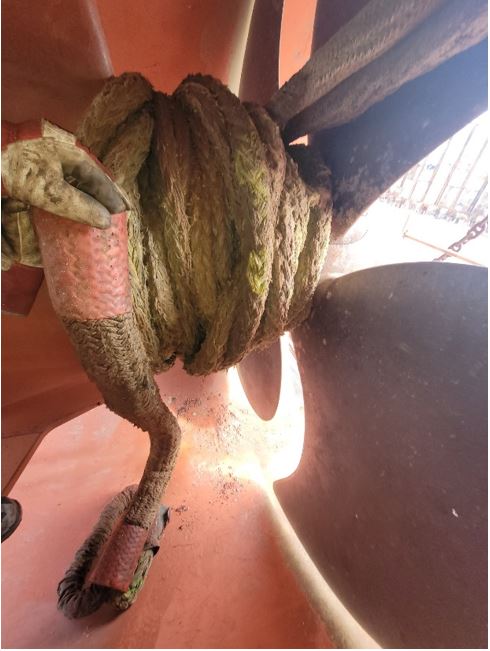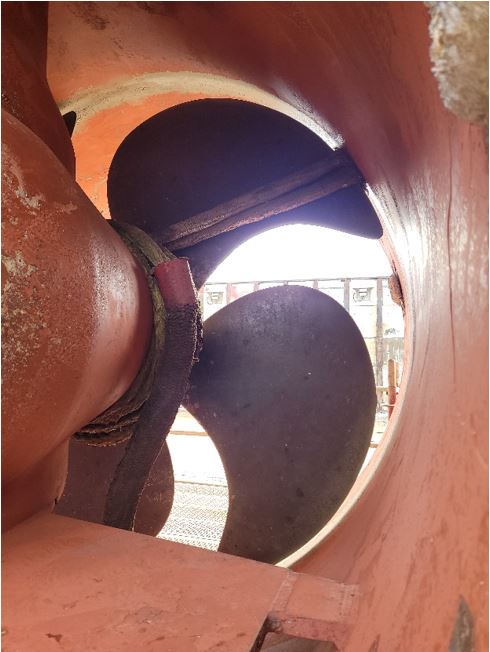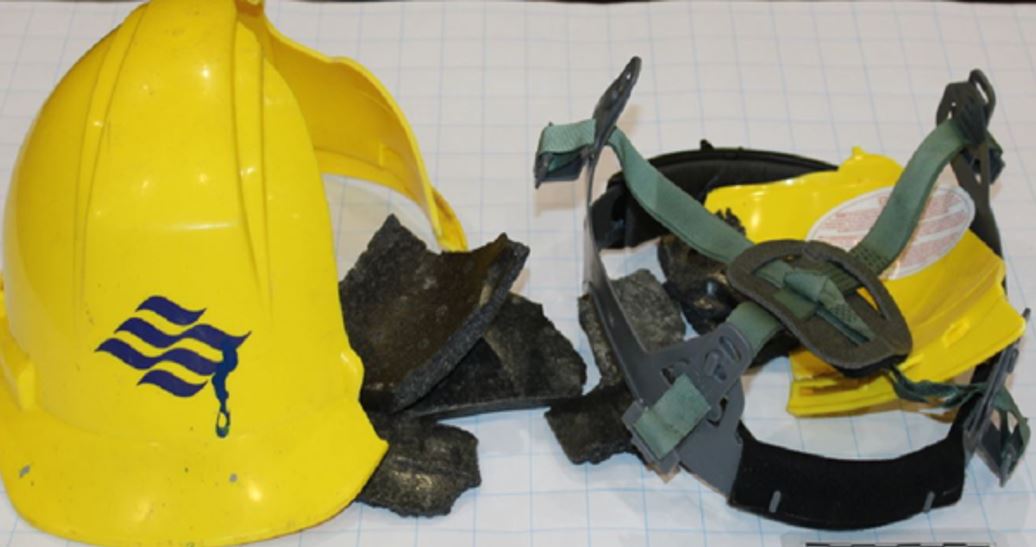Crew member injury during mooring operations
Roll-on/roll-off ferry Atlantic Vision
Les Méchins, Quebec
The Transportation Safety Board of Canada (TSB) investigated this occurrence for the purpose of advancing transportation safety. It is not the function of the Board to assign fault or determine civil or criminal liability. This report is not created for use in the context of legal, disciplinary or other proceedings. See Ownership and use of content. Masculine pronouns and position titles may be used to signify all genders to comply with the Canadian Transportation Accident Investigation and Safety Board Act (S.C. 1989, c. 3).
Summary
On 23 March 2023, the roll-on/roll-off ferry Atlantic Vision was unmooring in preparation to enter the dry dock at Les Méchins, Quebec. During the unmooring operations, one of the mooring lines was released from the dock into the water to be winched back onto the vessel. The line was drawn into one of the vessel’s bow thrusters and wrapped around the rotating thruster propeller shaft, causing the line to rapidly pull through the mooring winch on the forward mooring deck. As the line pulled through the winch, it struck and seriously injured an on-board crew member. The crew member was evacuated by air transport to a hospital in Québec, Quebec.
1.0 Factual information
1.1 Particulars of the vessel
| Name of vessel | Atlantic Vision |
|---|---|
| IMO number | 9211509 |
| Official number | 835621 |
| Port of registry | St. John’s, NL |
| Flag | Canada |
| Type of vessel | Roll-on/roll-off ferry |
| Gross tonnage | 30 285 |
| Registered length / Length overall (m) | 187.2 / 203.3 |
| Draft at time of the occurrence (m) | Forward: 4.96 Aft: 5.96 |
| Built | 2001 in Kiel, Germany |
| Propulsion | 4 diesel engines generating a total of 46 550 kW, driving 2 controllable-pitch propellers |
| Maximum complement | 700 passengers and 100 crew |
| Complement at the time of the occurrence | 50 crew |
| Owner | Baltic SF IX Ltd. |
| Authorized representative and operator | Marine Atlantic Inc.* |
| Recognized organization | DNV |
| Issuing authority for International Safety Management certification | Lloyd’s Register |
* At the time of the occurrence, Marine Atlantic Inc. had a bareboat charter with the vessel owner and will be referred to as the authorized representative of the vessel in this report. The vessel has since been returned to its owner.
1.2 Description of the vessel
The Atlantic Vision is a roll-on/roll-off ferry of steel construction (Figure 1). The vessel has 10 decks, including 4 vehicle decks accessible by ramps at the bow and stern. The enclosed bridge is located forward and includes all required navigation and communication equipment. The vessel has 4 diesel engines generating a total of 46 550 kW, driving 2 controllable-pitch propellers.
The Atlantic Vision made year-round ferry crossings between Port aux Basques, Newfoundland and Labrador, and North Sydney, Nova Scotia. It also made seasonal crossings between Argentia, Newfoundland and Labrador, and North Sydney. Between crossings, the Atlantic Vision moored with the assistance of line handlers who were familiar with the vessel and its mooring procedures.
1.2.1 Manoeuvring thrusters
The Atlantic Vision has 3 tunnel-type manoeuvring thrusters: 2 at the bow (Figure 2) and 1 at the stern. They provide lateral thrust and can be used to align the vessel with the dock, especially when space for manoeuvring is limited.
The 2 bow thrusters are each rated at 1950 kW and the stern thruster is rated at 1350 kW. Each thruster is powered by an electric motor driving a controllable-pitch propeller that can be operated to either port or starboard at degrees of pitch ranging from 0 to 100. At pitch 0, the thruster does not generate thrust, but the propeller shaft and blades continue to rotate.
There are 3 sets of controls for the thrusters located on the bridge: 1 set on the centre console and 1 set on each wing console. The controls consist of individual levers to adjust the pitch of the propeller, as well as emergency stop buttons for each thruster (Figure 3).
1.2.2 Mooring stations
The vessel has 4 mooring stations, all of which are on deck 5 and fully covered. Two of the mooring stations are located forward, separated by a vehicle ramp at midship. The other 2 are located aft in the same configuration.
The forward mooring stations are each equipped with 2 electric mooring winches: a stand-alone winch and a combination anchor windlass and mooring winch. The stand-alone winches have 2 split drums (inner and outer) and a warping drumA warping drum is a cylinder-like fitting at the end of the winch. The line can be hauled by winding a few turns around the warping drum, with the free end of the line being held taut manually as the warping drum rotates. (Figure 4). The inner and outer split drums can be operated independently of each other. The warping drum is always engaged while the winch is operating.
The starboard and port forward mooring stations have controls that allow for the forward mooring equipment to be operated from either station. The controls for the combination anchor windlass and mooring winches have 2 speed settings, with the slower speed typically used to handle the anchor and the faster speed used to handle the mooring lines.
At the time of the occurrence, the starboard-side controls for the starboard combination windlass and mooring winch would only operate on the slower speed setting, and the handle for the controls had been removed to prevent use until repairs were completed (Figure 5). The port-side controls for the starboard combination windlass and mooring winch still worked at both speeds. There was no direct line of sight from these controls to the winch due to the vehicle ramp at midship.
The mooring lines on the Atlantic Vision consist of 12-strand polyester blend ropes that are 44 mm in diameter. Each mooring line has an eye at either end that is covered with a 2.4 m-long protective sleeve of industrial nylon to guard against chafing. The lines have a certified average strength of 120 000 kg and minimum strength of 108 000 kg.
1.3 Les Méchins dry dock
Les Méchins dry dock is located on the south shore of the St. Lawrence River about 46 km east of Matane, Quebec (Figure 6). It is privately owned and operated by Groupe Océan, which acquired it from Verreault Navigation in 2022. Due to the design of the dry dock, vessels can only enter and exit during a specific window of time around high tide. Once a vessel has navigated into the dry dock, it is carefully positioned on blocks, the gate is closed, and the water is pumped out. The window to enter the dry dock is no later than 2 hours after high tide. In this occurrence, the Atlantic Vision was unmooring at around 1500, and high tide was at 1620. This meant there was a window of approximately 3 hours and 20 minutes for the vessel to enter the dry dock. The process normally takes 1 to 2 hours.
Some vessels moor at the public wharf while awaiting their turn in the dry dock. There are no line handler services available at the public wharf, but vessels can request assistance from the Les Méchins dock master, who will assemble a shore team consisting of various dry dock workers to help with mooring operations. Typically, some of the shore team members board a vessel if it is moored at the public wharf so that they are in position to take over mooring operations once the vessel reaches the dry dock gate. If the vessel’s crew is not proficient in French, the shore team members selected to board the vessel are chosen based on their working knowledge of English.
If the bridge team is unfamiliar with the area or not proficient in French, they can request the assistance of a local adviser who will board the vessel. The local adviser provides manoeuvring advice and helps with translating and relaying information between the vessel and shore when it is entering and exiting the dry dock. The local advisers are self-employed and work on an on-call basis. They perform a variety of services, including assisting vessels with docking at various docks (e.g., Sept-Îles [Quebec], Matane, etc.) as well as entering and exiting Les Méchins dry dock.
1.4 History of the voyage
On 22 March 2023, the Atlantic Vision departed from North Sydney bound for the dry dock at Les Méchins for its planned periodic survey. At 0730All times are Eastern Daylight Time (Coordinated Universal Time minus 4 hours). on 23 March, the vessel arrived off Les Méchins and waited outside the port area for the local adviser. At 1010, the local adviser boarded, and the vessel proceeded to the public wharf to wait for the dry dock to be available.
Because another vessel was preparing to leave the dry dock, the waiting time at the public wharf would be short, so the bridge team and dock master agreed to moor using 3 lines forward to secure the vessel’s bow and no lines at the stern. The vessel’s stern would be kept alongside with the stern thruster and the help of a tug. At 1110, the Atlantic Vision was secured alongside the public wharf.
While the Atlantic Vision waited for the vessel occupying the dry dock to vacate it, the master, the local adviser, and the dock master developed a plan for unmooring the Atlantic Vision and moving it into the dry dock. The plan was for the head line to be winched back onto the vessel and for the shore team to walk the breast line and spring line over to the dry dock.When the shore team walks lines over to the dry dock, they hold on to the end of the mooring lines once they are released from the bollards and then carry the lines from bollard to bollard as the vessel proceeds at slow speed into the dry dock. As it is a short distance from the public wharf into the dry dock, this process avoids the vessel having to winch in all the lines and then redeploy them shortly after arriving in the dry dock.
Because 2 different languages were in use, radio communications to coordinate the vessel’s manoeuvres into the dry dock would be transmitted on 2 different channels, with the vessel’s crew communicating in English on a vessel channel and the shore team communicating in French on a shore channel. The crew confirmed with the local adviser that he would facilitate communications between the 2 teams by listening to both the vessel and shore channels and relaying information between the master and the dock master as needed. The crew also finalized preparations to enter the dry dock, which included deballasting the vessel to reduce its draft forward to 4.96 m to allow it to go up on the blocks in the dry dock.The vessel’s normal operating draft forward was between 6.1 and 6.3 m.
At 1402, the shore team that would be assisting the Atlantic Vision was called to their stations, as were the Atlantic Vision’s mooring teams. The forward mooring team on the Atlantic Vision consisted of 5 crew members: the second officer, a carpenter, and 3 deckhands. The bridge team at that time consisted of the master, chief officer, a quartermaster, and the local adviser.
The shore team consisted of 8 dry dock workers and the dock master. The director of operations for the dry dock was also on the wharf to observe the operation. The plan was for 4 of the shore team members to board the vessel so they could take control of mooring operations once the vessel had entered the dry dock. Four shore team members were to remain on the wharf and tend to the mooring lines with the dock master supervising.
Around 1440, the 4 shore team members boarded the vessel. Two proceeded to the starboard aft mooring station and 2 proceeded to the starboard forward mooring station. The 2 who proceeded forward noticed that all 3 mooring lines in use were secured on the starboard forward mooring winch (winch M5),When the shore team is walking lines over to the dry dock, the preferred arrangement is to have the lines on separate winches. This is so that the lines can be controlled separately and so that, in the event of a problem with the winch, both lines are not compromised. with the head line on the warping drum.
The forward mooring team informed the 2 shore team members that the combination anchor windlass and mooring winch on the forward starboard side (winch W1) was not working properly and therefore could not be used. The shore team members inquired further about the state of winch W1 and were informed that the winch would pay out normally, but would only winch lines in on slow speed. The shore team members shared this information with the dock master, who then discussed the situation with the bridge team.
Between 1440 and 1500, the master, the local adviser, and dock master began discussing a revised plan for unmooring the Atlantic Vision from the public wharf in light of the problem with winch W1. During this discussion, the dock master used numbers to refer to the mooring lines, and the master used the names of the lines. At 1502, the master asked for clarification about the plan for the spring line. The local adviser explained that the spring line was line number 2, the term the shore team utilized, and the master and local adviser then continued to discuss which lines were on which winch.
At 1503, the dock master requested that an extra line be made standby on winch W1. One of the shore team members at the forward mooring station subsequently confirmed that the line had been made standby. The dock master then informed the local adviser that the shore team was ready for the unmooring operation to begin and that the shore team would walk with line number 2.
At 1504, the local adviser indicated to the master that the unmooring operation could begin with the breast line. The master told the second officer to begin the unmooring operation with the breast line and, shortly after, added that it was okay to proceed with the head line as well. The local adviser relayed on the shore channel that the vessel was beginning the unmooring operation with the breast line and the head line. The vessel’s 2 bow thrusters were operating. The pitch on the forward bow thruster was set at an angle intended to keep the vessel’s bow alongside. The pitch on the aft bow thruster was set to 0. The stern thruster was also still in use.
The second officer went to his post at the aft-most opening of the starboard forward mooring station from where he was visible to the rest of the forward mooring team as well as the shore team and could direct both with hand signals. On the second officer’s signal, the carpenter activated winch M5 and created slack on all 3 of the lines to facilitate releasing them from the bollards on the wharf. Suddenly, winch M5 stopped working. The second officer left his post and went to winch M5 to investigate the problem. He also informed the bridge. This information was relayed to the dock master by one of the 2 shore team members at the forward mooring station.
At 1505:30, the chief officer ordered an electrician to attend to winch M5, but at approximately 1507, it suddenly began operating again. The master then informed the second officer that the spring line did not need to be winched in because the shore team was going to walk it over.
The second officer remained beside winch M5 and began disengaging the drum holding the spring line so that only the breast line and head line would winch in. The carpenter was at the winch controls, 1 deckhand was forward near the roller fairlead used by the head line, 1 deckhand was tending to the head line on the warping drum, and 1 deckhand was coiling the slack from the head line on the deck (Figure 7). The unused portion of the head line was stored in the rope locker under the deck. The 2 shore team members at the forward mooring station were standing near winch W1 underneath fan outlets that generated a significant amount of noise.
At 1507:45, a shore team member at the forward mooring station broadcast a message indicating that the lines were going to be released. This was followed by a conversation between the shore team on the wharf and the shore team member on the vessel about whether the vessel was ready to bring up the lines, and the shore team member on the vessel indicated it was.
At some point after the master’s initial order to release the lines at 1504, the head line was released into the water. The investigation could not determine the exact timing and the circumstances around its release.
At 1508:04, one of the bridge team members stated that there was a line stuck in the bow thruster. At the same time, one of the shore team members at the forward mooring station broadcast a message indicating that a line was getting close to the thruster. Between 1508:14 and 1508:16, one of the shore team members on the wharf broadcast messages that the line was dangerously close to the thruster and then in it. At 1508:23, the director of operations also observed the head line in the thruster’s tunnel and asked the local adviser to stop the bow thruster.
The local adviser, upon receiving the request from the director of operations, immediately told the master that there was a line in one of the thrusters and asked him to stop the thruster. The master set the forward bow thruster’s pitch to 0.
Meanwhile, at the forward mooring station, the head line had come under tension and started slipping on the warping drum. The deckhand who was holding the head line made an additional turn on the warping drum to stop the movement of the line. Around this time, the shore team members on the wharf observed the head line coming under extreme tension and ran to take cover in case the head line snapped back.
At 1508:51, the head line rapidly pulled through the warping drum and struck the deckhand on the head, destroying his hard hat and seriously injuring him (Figure 8).
1.5 Environmental conditions
At the time of the occurrence, the air temperature was 0 °C and the skies were overcast with visibility of 10 nautical miles. The wind was from the east-northeast at 10 knots, and the swell was from the northeast with waves of 0.1 m in height. The tide was flooding and was low at 1008 (0 m), high at 1620 (3.2 m), and low again at 2223 (0.3 m).
1.6 Damage
The forward bow thruster was rendered inoperable until the mooring line wound around it was cut and removed (figures 9 and 10).
1.7 Vessel certification
The Atlantic Vision carried all the required certificates for a vessel of its class and intended voyage. Its last intermediate survey was carried out by DNV on 26 November 2021. The last time the vessel was in dry dock was at Les Méchins in November 2020.
1.8 Personnel experience and certification
1.8.1 Atlantic Vision
The master held a Master Mariner certificate and had been employed with Marine Atlantic Inc. for 34 years. He had held the position of master for 15 years and had become master on the Atlantic Vision in 2010. Prior to the occurrence, the master had gone into Les Méchins dry dock as master on the Atlantic Vision once before, in November 2020.
The chief officer held a Master Mariner certificate and had been employed by Marine Atlantic Inc. for 6 years. He had worked primarily as a chief officer for 2 years.
The second officer held a Watchkeeping Mate certificate and had been employed by Marine Atlantic Inc. for 20 years. He had worked as a second officer for 16 years.
The 3 deckhands at the forward mooring station all held bridge watch certificates and had each been employed by Marine Atlantic Inc. for at least 2 years.
The Atlantic Vision’s master and deck officers all held General Radio Operator certificates.
1.8.2 Local adviser
The local adviser held a Master Mariner certificate. He mainly worked in the Port of Sept‑Îles, but also contracted out his services to vessels docking in the region of Matane and Les Méchins. The occurrence was his second time boarding the Atlantic Vision to bring it into Les Méchins dry dock, having also been on board when the vessel went into dry dock in November 2020.
The local adviser also held a General Radio Operator certificate.
1.8.3 Dry dock personnel
The dock master had started working at the dry dock in 2017, becoming a superintendent in 2019 and dock master in 2020. Prior to starting work at the dry dock, the dock master had 18 years of experience, mainly as a bridge watch rating.
The 8 shore team members that were assisting with unmooring the Atlantic Vision were trained in various trades relevant to dry dock work (e.g., electricians, welders, mechanics, and painters). They regularly assisted vessels with entering and exiting the dry dock.
Verreault Navigation had originally provided the dry dock workers with a manual that was a copy of Principes de sécurité à l’amarrage developed by Institut maritime du Québec at Cégep de Rimouski.Institut maritime du Québec, Cégep de Rimouski, Principes de sécurité à l’amarrage (September 2012), at https://www.csmoim.qc.ca/public_upload/files/organismes-entreprises-maritimes/sante-securite/principes-de-securite-a-l_amarrage-guide-eleve.pdf (last accessed 09 September 2024). This manual gave an overview of shipboard mooring operations that was intended to familiarize seafarers with processes and equipment used on vessels during these operations. The shore team members were also given a 2-day training session that was based on the content covered in the manual. The first day of the training session focused on theory, and the second day focused on practice. Once a year, the shore team members had refresher training on elements of basic safety in mooring operations.
1.9 Radio communications
The Innovation, Science and Economic Development Canada website provides general radio operating procedures for use by the public.Industry Canada, RIC-22 – General Radio Operating Procedures, at https://ised-isde.canada.ca/site/spectrum-management-telecommunications/sites/default/files/attachments/2022/ric22e.pdf (last accessed 09 September 2024). In the marine industry, masters and bridge officers are required to take radio communication training. This training is intended to standardize communication and reduce the risk of miscommunications.
There is no training required for day-to-day internal radio operations, such as those conducted at the dry dock, and the dry dock workers did not have training in radio procedures. Radio communications to coordinate a vessel’s manoeuvres into Les Méchins dry dock are typically transmitted on 2 different channels, a vessel channel and a shore channel. In this occurrence, the vessel’s crew was using ultra high frequency radios, and the shore team was using very high frequency radios. The local adviser on board was responsible for monitoring both channels and translating and relaying information between the master and the dock master when necessary.
1.10 Safety management
A safety management system (SMS) is an internationally recognized framework that allows companies to identify hazards, manage risks, and make operations safer—ideally before an accident occurs. An SMS uses a documented, systematic approach and provides individuals at all levels of a company with the tools they need to make sound decisions in routine and emergency operations. The policies, procedures, practices, training, and safety culture of a company are the outputs of an SMS. Risk management within an SMS is an ongoing cycle that helps companies and vessel operators identify, assess, mitigate, and follow up on existing and potential risks to vessels, personnel, and the environment.
At the time of the occurrence, only Canadian vessels that operated on international voyages and were subject to Chapter IX of the International Convention for the Safety of Life at Sea (the International Safety Management Code) had to comply with the domestic Safety Management Regulations. Although not required by regulation, Marine Atlantic Inc. had voluntarily developed an SMS for its fleet that was audited and certified by Lloyd’s Register for compliance with the International Safety Management Code. Among other things, its SMS includes guidance for mooring operations, guidance on the use of personal protective equipment, and documents to support master–pilot exchanges.
1.10.1 Mooring and unmooring operations
Marine Atlantic Inc. had a variety of documents in its SMS that addressed mooring and unmooring operations, including a general procedure in the Fleet Operations Manual, as well as some vessel-specific documents, such as work instruction manuals and safe work checklists.
The general procedure was intended for the Marine Atlantic Inc. fleet as a whole. The procedure indicated that the vessel’s officers should familiarize themselves with the principles of mooring as per their vessel’s mooring equipment, lines, design loads, etc. It also gave some advice about bridge team communication and safety during mooring operations, noting that the officer in charge needs to be visible and easily heard when conducting mooring operations. The majority of the content covered in the procedure related to different types of mooring systems and considerations related to these systems. The procedure indicated that for unusual or non-standard mooring arrangements, a risk assessment form needed to be completed. A risk assessment form had been completed before the Atlantic Vision arrived in Les Méchins, which primarily covered concerns related to the vessel’s stability.
The Atlantic Vision’s Work Instructions Manual included a chapter that covered the steps involved in mooring. The chapter specified the personnel needed at a mooring station as well as considerations when securing mooring lines, such as ensuring that “slack mooring line is kept out of water.”Marine Atlantic Inc., Work Instructions Manual MV Atlantic Vision (revision WV-2016-001, issued March 2016), Chapter 11, p. 22.
The vessel also had a safe work checklist for mooring that was intended to be completed prior to each mooring operation. It included items to consider in mooring operations, such as making sure all persons have appropriate personal protective equipment and that the order of the lines for mooring operations is clearly understood. It also specified that the officer in charge was to keep a watch on the deck crew, the lines handlers, and the mooring lines. The investigation was not provided a copy of the safe work checklist that was completed prior to this occurrence.
Finally, the vessel had a job safety analysis (JSA) specifically for unmooring.The job safety analysis was required to be reviewed and signed off by all participating crew once a shift. It had been signed by the occurrence crew but was not dated. The JSA identified steps involved in unmooring, as well as potential hazards associated with each step, and preventive measures to mitigate the hazards. The JSA identified a risk associated with the vessel engines and thrusters running when the lines were released. The associated potential hazards were listed as uncontrolled vessel movement, property damage, injury, death, or fouling of the mooring line in the vessel’s thrusters or propellers. The JSA identified 2 preventive measures: “proper communication between all parties prior to commencing unmooring” and for the “master to ensure proper vessel movements while unmooring.”Marine Atlantic Inc., Job Safety Analysis: Un-Mooring Operations (15 August 2018), p. 1.
1.10.2 Personal protective equipment
The chapter in the Atlantic Vision’s Work Instruction Manual that covered the steps involved in mooring specified that at all applicable personal protective equipment was to be worn at all times. The safe work checklist and the JSA also prompted crew to make sure they were wearing appropriate personal protective equipment. In this occurrence, the forward mooring team was wearing the required personal protective equipment, including approved hard hats.
1.10.3 Exchange of information between vessel and local adviser
The SMS included a pilot card to be filled out to facilitate the exchange of information between the master and pilots. The pilot card was intended to provide essential information about the vessel and its equipment, including the condition of the equipment.
In preparation for the local adviser boarding at Les Méchins on 23 March, the pilot card was filled out on 18 March, and no operational defects with any equipment were noted on the card. The issue with winch W1 had been identified on 17 March. Once the local adviser boarded, the problem with winch W1 was not communicated to him and therefore he was not aware of it when the initial plan for unmooring was developed. The local adviser was informed of this only when the shore team reached the forward mooring station.
1.11 Team situational awareness
When people operate in a team environment, team situational awareness is important for safe and effective operations. Team situational awareness involves having a shared perception and comprehension of the current situation in order to be able to project what will happen in the near future. Perception, comprehension, and prediction are driven by the information available to the team, the team’s experience and knowledge, and the overriding context. Effective team situational awareness allows team members to develop performance expectations and to understand how their individual roles support the team’s goals. As team members develop a shared understanding of a situation, they can communicate to cross-check their perceptions of the situation with each other.
For team situational awareness to develop and be maintained, the right information needs to get to the right person at the right time, which involves coordination among the team.K. T. Harris, C. M. Treanor, and M. L. Salisbury, “Improving patient safety with team coordination: challenges and strategies of implementation,” Journal of Obstetric, Gynecologic, and Neonatal Nursing, Vol. 35, Issue 4 (2006), pp. 557–566. A team’s effectiveness is often a reflection of the degree to which team members share information (e.g., questioning, cross-checking, coordinating, setting priorities, and contingency planning).C. A. Bowers, F. Jentsch, E. Salas, and C. C. Braun, “Analyzing communication sequences for team training needs assessment,” Human Factors, Vol. 40, Issue 4 (1998), pp. 672–679.
Team situational awareness can be compromised by breakdowns in communication. These breakdowns may result in information that is shared too late to be of use, that is not consistently complete and accurate, or that is ambiguous. They may also result in problems that are left unresolved until a point of urgency.A. Parush, C. Kramer, T. Foster-Hunt, K. Momtahan, A. Hunter, and B. Sohmer, “Communication and team situation awareness in the OR: implications for augmentative information display,” Journal of Biomedical Informatics, Vol. 44, Issue 3 (2011), pp. 477–485.
1.12 Mooring winches
The Atlantic Vision had 6 electric stand-alone winches and 2 electric combination anchor windlass and mooring winches. The mooring equipment was manufactured by Rolls-Royce in 2000 and installed on the vessel the same year. The equipment was designed and manufactured according to recognized industry standards at the time. Although the mooring equipment was designed by Rolls-Royce, the winches contained frequency converters that were manufactured by another company, Vacon.
Marine Atlantic Inc.’s SMS required critical equipment, such as winches, to be listed in the vessels’ planned maintenance systems and that periodic maintenance be monitored. The maintenance schedules for critical equipment were based on information provided by manufacturers in user manuals. At the time of the occurrence, the vessel had a user manual that covered the 6 stand-alone winches and the 2 combination anchor windlass and mooring winches. The manual included a statement on the first page to refer to the Vacon user manual for information regarding the frequency converters. The vessel did not have a copy of the Vacon user manual on board at the time of the occurrence. The TSB obtained a copy of the Vacon user manual and determined that it was mainly focused on how to program the converters and did not include any maintenance guidelines.
At the time of the occurrence, the Vacon frequency converter in winch M5 was the original converter (Vacon CX) dating back to when mooring equipment was first installed on the vessel in 2000. In 2005-06, a new generation of Vacon frequency converters was made available (Vacon NX). The CX generation became obsolete in 2012, and Vacon stopped supplying parts for this generation.
In 2014, winch M5 began having problems and a technician was called to look at it. The technician recommended that the frequency converter be upgraded during the vessel’s next scheduled service as there were no parts available to repair it. Another technician looked at the winches when the vessel was in dry dock in 2015. This technician confirmed that the software was obsolete and attempted to upgrade all of the winches but was unable to do so for 3 of them (W1, W2, and M5) for unknown reasons. It was decided to leave this equipment as it was since it had been working within set parameters.
On 17 March 2023, winch W1 was reported to not be working properly. This report triggered a series of emails between the vessel’s crew, company personnel, and external technicians aimed at troubleshooting the issue prior to the vessel’s arrival at the dry dock. However, despite troubleshooting attempts, it was not possible to get the winch fully operational prior to the occurrence.
A technician who visited the vessel after the occurrence could not determine exactly why winch M5 stopped working at the time of the occurrence, but he noted in his report that the frequency converter in the winch was an original Vacon CX and needed to be upgraded to NX for the winch to continue working safely. The technician noted that the expected life cycle for the circuit boards inside the frequency converter was 10 years. The technician also established that the problem with winch W1 originated from a connection between the control handle and the control block.
Following the occurrence, Marine Atlantic Inc. replaced the obsolete components in winches W1, W2, and M5, and repaired the issue with the winch W1 controls.
At the time of the occurrence, mooring winches were not typically covered by classification society surveys. They were also not covered by statutory inspections, which only check the connection of the winch to the deck.Post-occurrence, the Vessel Construction and Equipment Regulations were amended to include requirements for design, maintenance, and inspections of mooring equipment.
1.13 Previous occurrences
From 2013 to 2023, the TSB has received reports of 19 occurrences (including this occurrence) involving injury or death during mooring operations.Data on all marine transportation occurrences since 1995 is available on the TSB website at https://www.tsb.gc.ca/eng/stats/marine/data-6.html. It is updated monthly. As a result of these occurrences, 18 persons sustained serious injuries and 2 persons were fatally injured. In 2 of the occurrences, crew members were seriously injured by a mooring line fouling a propeller.
1.14 TSB Watchlist
The TSB Watchlist identifies the key safety issues that need to be addressed to make Canada’s transportation system even safer.
Safety management is a Watchlist 2022 issue. Some transportation operators are not managing their safety risks effectively, and many are still not required to have formal safety management processes in place. Moreover, those operators that have implemented a formal SMS are not always able to demonstrate that it is working and producing the expected safety improvements. As this occurrence demonstrates, not all vessel operators are required to have an SMS and even if safety management processes are in place, certain risks may not have been mitigated.
ACTION REQUIRED The issue of safety management in marine transportation will remain on the Watchlist until
|
1.15 TSB laboratory reports
The TSB completed the following laboratory report in support of this investigation:
- LP102/2023 – Hard hat analysis
The TSB laboratory examined the hard hat worn by the crew member who was injured in the occurrence to determine if it met regulations and to estimate the forces required to damage it.
The laboratory analysis determined that, at the time of the occurrence, the hard hat was in a serviceable condition and was well maintained. The hard hat conformed with CAN/CSA Z94.1-15, a standard published by the Standards Council of Canada that applies to protective headwear. Conformance with CAN/CSA Z94.1-05 is required by the Maritime Occupational Health and Safety Regulations.CAN/CSA Z94.1-15 was the latest revision of the standard for protective headwear at the time of the occurrence. The Maritime Occupational Health and Safety Regulations reference an earlier version of this standard (CAN/CSA Z94.1-05).
The laboratory analysis could not conclusively quantify the force that was applied to the hard hat during the occurrence. However, the analysis could reasonably demonstrate that the whip velocity was likely over the maximum for an impact to the crown or side of the hard hat. As a result, the hard hat shell broke while absorbing a significant amount of energy (Figure 11). This reduced the energy that was transmitted to the hard hat suspension assembly.
Finding: Other
The crew member’s use of an appropriate hard hat likely prevented a more serious injury.
2.0 Analysis
One of the crew members on the Atlantic Vision was seriously injured after a mooring line became entangled in the vessel’s bow thruster and was rapidly pulled through a mooring winch, striking a crew member. The analysis will look at the unmooring operation on the day of the occurrence, with a focus on the planning and communication. It will also look at the condition of the mooring equipment on the vessel.
2.1 Unmooring operation on the day of the occurrence
The unmooring operation started with the forward mooring team operating the mooring winch to create slack on the lines to facilitate the release of the lines from the bollards. Once the lines were slack, the winch suddenly stopped operating. The second officer left his assigned post to investigate the problem and was therefore not able to continue supervising the mooring lines and line handlers.
When the winch suddenly started working again, there was a discussion on the shore team’s radio channel that may have created an impression that it was time to release the lines into the water. The exact timing and circumstances around the release of the head line into the water could not be determined by the investigation. It is possible that the head line was released after this discussion, but it is also possible that the head line was released at some point prior to this, after the bridge initially gave the order to begin the unmooring operation. Regardless of the timing, the forward mooring team did not know the head line had entered the water and remained under the impression that all of the mooring lines were still on the bollards.
Finding as to causes and contributing factors
A breakdown in communication during the unmooring operation resulted in the head line being released into the water without the forward mooring team being aware.
At the time of the occurrence, the vessel’s draft had been reduced for dry docking, and the thrusters were just below the water’s surface. To keep the vessel’s bow close to the wharf, the forward bow thruster was in operation. On the Atlantic Vision, the bow thrusters do not have any protective covering to prevent unwanted items from entering them. The action of the forward bow thruster resulted in the head line moving toward it.
There was only about 1 minute between when the head line was first noticed near the bow thruster and when it pulled through the warping drum and injured the deckhand. This meant there was a limited amount of time to comprehend the unfolding situation, communicate information to those who needed it, and take action. When the local adviser received a message about a line in the thruster, he immediately relayed this information to the master and asked him to stop the bow thruster. Based on the information received, the master set the pitch to 0, which stops the thruster from drawing water. However, at pitch 0, the bow thruster’s propeller shaft and blades continued to rotate, wrapping the line around the shaft.
Finding as to causes and contributing factors
The vessel’s bow thruster drew in the head line and caused it to wrap around the thruster’s propeller shaft.
Because the operation was being carried out on 2 different radio channels in 2 different languages, information did not get to everyone at the same time. For example, because the conversations about a line in the thruster took place on the bridge and on the shore team’s radio channel, the forward mooring team did not receive any information about the developing situation. Without knowing that the head line had been released and was caught in the thruster, the forward mooring team was unaware of the risk to their safety and did not have an opportunity to take cover.
Finding as to causes and contributing factors
The use of 2 different radio channels meant that warnings about the line in the thruster did not reach the vessel’s forward mooring team and, consequently, they were unaware of the risk to their safety.
As the submerged end of the head line was drawn into the bow thruster and began wrapping around its propeller shaft, the rest of the line came under tension because it was still on the mooring winch warping drum. The tension caused the head line to start slipping on the warping drum. The deckhand noticed that the head line was slipping but, without having any information about the developing situation, perceived this to mean that the vessel was moving away from the dock. He made an additional turn on the warping drum; however, the tension on the head line continued to build as the line wrapped around the rotating bow thruster shaft. Once the tension reached a critical point, the head line pulled out of the rope locker and through the warping drum, striking the deckhand and seriously injuring him.
Finding as to causes and contributing factors
The tension of the head line wrapping around the bow thruster propeller shaft pulled the head line out of the rope locker and through the mooring winch warping drum, striking and seriously injuring a deckhand.
2.2 Planning for the unmooring operation
Unmooring operations can pose risks to those on a vessel and those ashore. The planning phase of this operation provides an opportunity to conduct a risk assessment and ensure that any identified hazards are mitigated. Planning also ensures that everyone involved has a shared understanding of how the operation will proceed and that their actions are coordinated.
For the Atlantic Vision, unmooring was typically a routine operation performed in a familiar location with line handlers who knew the vessel and its procedures. However, in this occurrence, the unmooring operation was different than normal. The vessel and shore teams were not familiar with each other, and the operation was being conducted in 2 different languages on 2 different radio channels. There were 17 people directly involved in the unmooring operation, 5 of whom had supervisory roles. The vessel was in a location unfamiliar to its crew, and its condition was different from usual given that it had a reduced draft and a winch that was not working properly.
A risk assessment for dry docking the Atlantic Vision had been carried out; however, it focused primarily on stability considerations and did not take into account risks associated with entering and exiting the dry dock, such as using the bow thrusters at reduced draft while unmooring. While the job safety analysis for unmooring identified a risk associated with the vessel engines and thrusters running when the lines were released, the preventive measures provided were general in nature, and the investigation was unable to determine whether the job safety analysis was reviewed prior to the occurrence operation.
Without a comprehensive risk assessment of the unmooring operation, there were some hazards that went unmitigated during the planning phase. For example, using 1 winch to control all of the lines posed a risk that the vessel could lose control of all of the lines in the event of equipment failure. Additionally, using the bow thrusters at reduced draft meant that they were acting closer to the surface and posed a risk of lines being drawn into them. Precautions might include shutting down the bow thrusters once lines enter the water or advising the line handlers to take steps to minimize the amount of line in the water. When it is necessary to keep thrusters and propellers operating during unmooring operations, caution must be exercised due to the risk of fouling the lines.
Finding as to risk
If an operation is not assessed for risk, hazards may go unidentified or unmitigated, jeopardizing the safety of the operation.
It is important that everyone have a shared understanding of how an unmooring operation will be carried out, particularly if it is being conducted in conditions that are different than usual. In this occurrence, neither the local adviser nor the dock master was notified of the problem with winch W1 when the initial unmooring plan was being developed. The plan therefore had to be revised at the last minute when the shore team reached the forward mooring station and noticed that all of the mooring lines were on the same winch. Once the plan was revised, it was not fully communicated to all of the individuals involved before the unmooring operation got underway.
As well, the vessel’s crew and shore team were not familiar with each other, and the shore team was unfamiliar with the vessel’s normal unmooring procedure. There were no records to indicate that the vessel’s crew and shore team had reviewed the unmooring procedure to ensure a shared understanding. The vessel’s crew and shore team were also using different terminology to refer to the mooring lines, which had the potential to create misunderstandings.
Finding as to risk
If planning for a vessel’s operation does not result in everyone involved having a shared understanding of how it will proceed, it may not go as intended and put the safety of the vessel and personnel at risk.
2.3 Communication during the unmooring operation
Communication is a key part of coordinating the actions of teams both on a vessel and ashore during unmooring operations. Effective communication supports team situational awareness and allows the teams to work together to accomplish a common goal. Conversely, team situational awareness can be compromised by breakdowns in communication.
In this occurrence, there were a few breakdowns in communication during the operation that impacted team situational awareness and subsequent actions taken. One related to the release of the head line into the water, and another related to the misunderstanding around shutting down the bow thruster. These breakdowns illustrate the importance of effective communication to support team situational awareness and ensure that the right information gets to those who need it when they need it.
There was also a breakdown in communication that resulted in the forward mooring team not receiving any information about the line in the thruster because the conversations about it took place on the bridge and on the shore channel, but not on the vessel’s channel. This communication breakdown resulted because the operation was being carried out on 2 different radio channels in 2 different languages, and so not all individuals involved in the operation were privy to the same information at the same time. To compensate for this, the local adviser was being relied on to translate and relay messages between the master and the dock master. However, this task was challenging given the numerous messages being transmitted, at times simultaneously on both radio channels, using non-standard radio procedures. This meant that it took more time for information to get to recipients, and the context and relevance of information being transmitted was sometimes lost.
There are various ways to support effective communication in an operation. Ensuring that an operation has a clear plan and that all team members are aware of the plan provides the basis from which effective communication can proceed. The use of standardized terminology and radio procedures can facilitate clear communication and reduce the chances of misunderstandings. If 2 languages are in use, all parties must be aware that language barriers can result in misunderstandings or some individuals receiving information while others do not. In these cases, it may be necessary to slow down the operation and cross-check people’s understandings to ensure team situational awareness. Having emergency signals that are well understood and practised can also facilitate the transmission of urgent messages.
Finding as to risk
If communication during a vessel’s operation does not support team situational awareness, there is a risk that breakdowns in communications will occur, impeding the success of the operation and impacting the safety of the vessel and personnel.
2.4 Condition of mooring winches
For the safety of mooring and unmooring operations, it is essential that critical components, such as winches, are reliable and well-maintained. Three of the winches on the Atlantic Vision had frequency converters that were obsolete. Obsolete components are at risk of unpredictable failure, especially without regular maintenance. As well, if they do fail, parts may not be available. Despite an attempt by a technician in 2015 to upgrade all of the winches, 3 of them could not be upgraded for unknown reasons. This resulted in the vessel operating another 7 years with 3 winches known to contain obsolete components. At the time of the occurrence, 2 of these winches were not operating as intended.
Finding as to risk
If critical vessel components become obsolete, there is a risk that they will fail during operations and compromise the safety of the vessel and personnel.
3.0 Findings
3.1 Findings as to causes and contributing factors
These are conditions, acts or safety deficiencies that were found to have caused or contributed to this occurrence.
- A breakdown in communication during the unmooring operation resulted in the head line being released into the water without the forward mooring team being aware.
- The vessel’s bow thruster drew in the head line and caused it to wrap around the thruster’s propeller shaft.
- The use of 2 different radio channels meant that warnings about the line in the thruster did not reach the vessel’s forward mooring team and, consequently, they were unaware of the risk to their safety.
- The tension of the head line wrapping around the bow thruster propeller shaft pulled the head line out of the rope locker and through the mooring winch warping drum, striking and seriously injuring a deckhand.
3.2 Findings as to risk
These are conditions, unsafe acts or safety deficiencies that were found not to be a factor in this occurrence but could have adverse consequences in future occurrences.
- If an operation is not assessed for risk, hazards may go unidentified or unmitigated, jeopardizing the safety of the operation.
- If planning for a vessel’s operation does not result in everyone involved having a shared understanding of how it will proceed, it may not go as intended and put the safety of the vessel and personnel at risk.
- If communication during a vessel’s operation does not support team situational awareness, there is a risk that breakdowns in communications will occur, impeding the success of the operation and impacting the safety of the vessel and personnel.
- If critical vessel components become obsolete, there is a risk that they will fail during operations and compromise the safety of the vessel and personnel.
3.3 Other findings
These items could enhance safety, resolve an issue of controversy, or provide a data point for future safety studies.
- The crew member’s use of an appropriate hard hat likely prevented a more serious injury.
4.0 Safety action
4.1 Safety action taken
4.1.1 Marine Atlantic Inc.
Marine Atlantic Inc. conducted an internal investigation that made several recommendations to prevent similar occurrences.
As a result, the job safety analysis was reviewed and training was conducted. For the next vessel that was dry docked subsequent to the occurrence, the vessel’s crew and shore technical superintendents reviewed the risk analysis register, and a pre-docking meeting was conducted with the shipyard. Marine Atlantic Inc. indicated that further refinements to job safety analyses and safe work procedures will be part of each dry dock preparation meeting and that updates will be tracked.
4.1.2 Groupe Océan
Groupe Océan conducted an internal investigation and made additions to an existing checklist that a vessel’s crew is required to fill out before they arrive at the dry dock. The additions include obtaining a sketch from the vessel of its planned mooring line configuration and requesting more specific information about the operational status of the vessel’s mooring winches.
This report concludes the Transportation Safety Board of Canada’s investigation into this occurrence. The Board authorized the release of this report on 25 September 2024. It was officially released on 08 October 2024.
